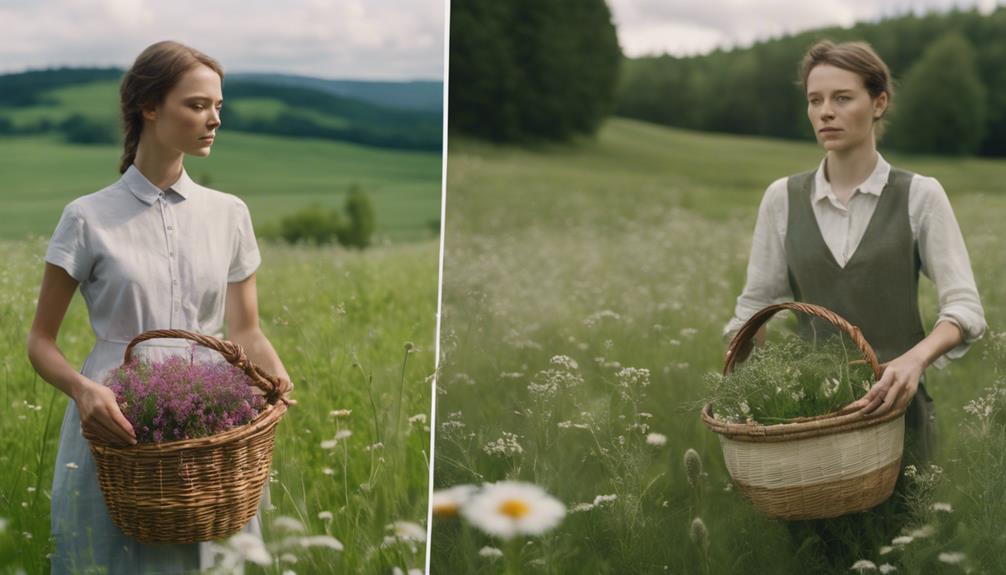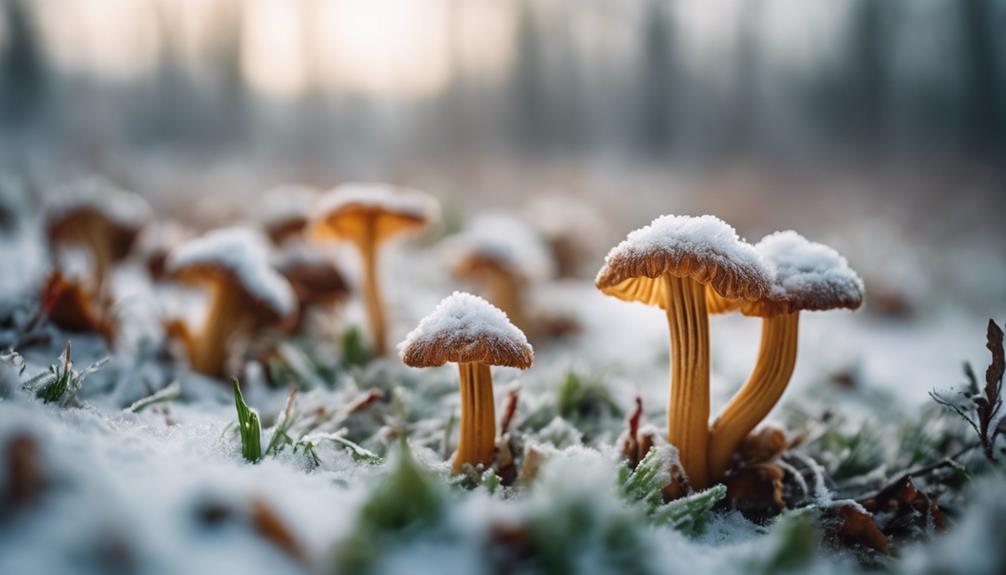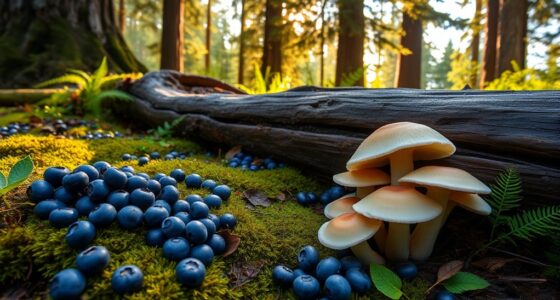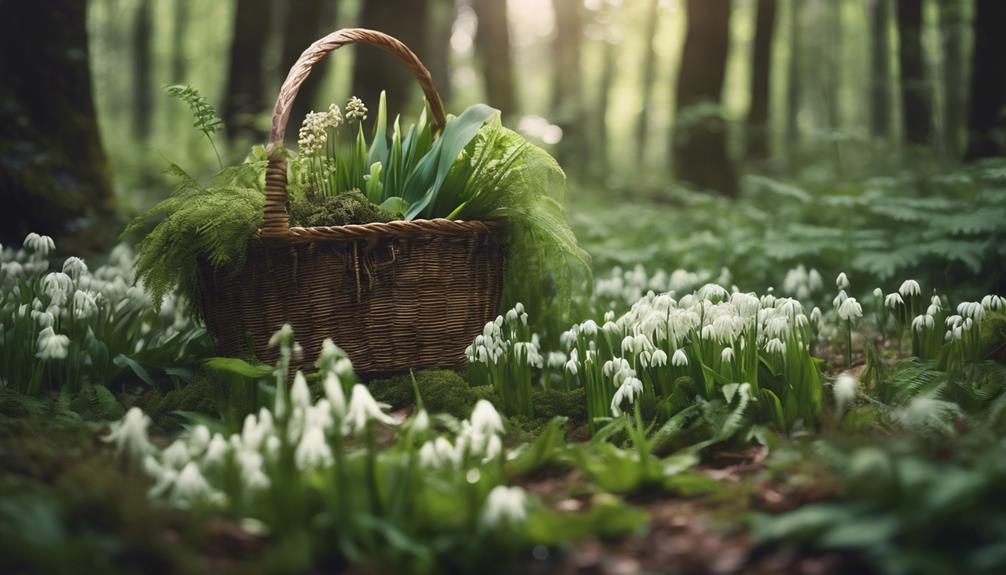In September, forage nature's bounty by exploring woods, hedgerows, and heathland for berries, nuts, vegetables, herbs, and seeds. From elderberries for jams to hazelnuts for roasting, the possibilities are diverse. Harvest vegetables in the morning, clean them promptly, and use sharp tools for the task. Discover herbs like mint and oregano, and explore medicinal options like echinacea. Safety is key when foraging; identify plants correctly, wear protective gear, and practice ethical harvesting. Explore further to learn about identifying nuts, seed harvesting, and preserving your late summer finds for culinary adventures and winter delights.
Key Takeaways
- Forage for blackberries, elderberries, hawthorn berries, and rosehips in woods and hedgerows.
- Harvest hazelnuts, oaknuts, and seasonal fruits like sloes for culinary versatility.
- Gather herbs like mint, basil, and thyme for cooking and medicinal benefits.
- Preserve late summer bounty by canning tomatoes, freezing herbs, and making sauces.
- Practice ethical foraging, wear protective gear, and identify plants accurately for safety.
Foraging Locations in September

In September, explore woods, hedgerows, and heathland for the best foraging locations to harvest late summer bounty.
Hedgerows, in particular, offer a diverse array of edible treasures waiting to be discovered. These natural boundaries between fields or along roadsides are often teeming with blackberries, elderberries, hawthorn berries, and rosehips during this time of year. Their dense tangles provide a safe haven for various fruits to flourish and ripen, making them a prime spot for foragers looking to gather a variety of late summer treats.
As you venture into the hedgerows, remember the importance of leaving plenty of foraged items behind for the wildlife that depend on these resources. Squirrels, birds, and other creatures rely on these fruits to survive as they prepare for the coming winter months.
Seasonal Fruits to Forage

Explore the woodland areas in September to discover a variety of seasonal fruits ripe for foraging, including blackberries, sloes, hawthorn berries, rosehips, elderberries, and hazelnuts. These late summer treasures offer a mix of flavors and nutritional benefits waiting to be picked.
Elderberries, known for their deep purple hue and tart taste, can be used in jams, syrups, or even wines. Hazelnuts, encased in a hard shell, provide a rich, buttery flavor perfect for snacking or adding to baked goods.
Foragers in September can also stumble upon sweet chestnuts and oaknuts (acorns), adding to the array of nuts available for harvesting. Whether you're a seasoned forager or new to the practice, gathering these seasonal fruits and nuts not only offers a connection to nature but also opens up a world of culinary possibilities.
From pies and preserves to roasted nuts for snacking, the bounty of September's fruits and nuts invites creativity in the kitchen and promotes sustainable foraging practices.
Vegetable Harvesting Tips

Consider harvesting vegetables in the morning to guarantee the best flavor and nutritional value.
When foraging for vegetables, follow these tips to make sure a successful harvest:
- Use the Right Tools: Employ a sharp knife or pruners when harvesting vegetables. This helps you cut them cleanly from the plant without causing damage.
- Wash Immediately: After harvesting, wash the vegetables promptly. This step removes any dirt or pests that may have hitched a ride from the garden to your kitchen.
- Proper Storage: Store harvested vegetables in a cool, dry place. This will help maintain their freshness and extend their shelf life.
- Succession Planting: Consider succession planting to guarantee a continuous supply of fresh vegetables throughout the season. By staggering your plantings, you can enjoy a steady harvest instead of a one-time bounty.
Following these tips will enhance your foraging experience and make the most of your vegetable harvest.
Herbs for Late Summer Foraging

Late summer provides an abundance of herbs for foraging, such as mint, basil, oregano, thyme, and rosemary. These flavorful herbs can enhance your dishes with fresh, aromatic notes.
Mint is renowned for its cooling properties, while basil, oregano, thyme, and rosemary contribute fragrant and savory touches to a variety of culinary creations.
Medicinal Herb Benefits
Discover the diverse health benefits of medicinal herbs commonly foraged in late summer, such as echinacea, lemon balm, and chamomile. These herbs offer a range of advantages for your well-being:
- Echinacea:
- Boosts the immune system.
- Effective in treating colds and respiratory infections.
- Lemon Balm:
- Reduces stress and anxiety.
- Improves sleep quality and relaxation.
- Chamomile:
- Known for its calming effects.
- Helps with digestion issues like bloating and indigestion.
Foraging these medicinal herbs in late summer provides a natural and holistic approach to managing various health concerns. Echinacea's immune-boosting properties can aid in preventing seasonal illnesses, while lemon balm's stress-reducing qualities offer a natural way to relax and unwind.
Chamomile's calming effects can help alleviate digestive discomfort, making it a versatile herb for overall well-being. By incorporating these herbs into your routine, you can harness the power of nature to support your health and well-being.
Culinary Herb Uses
Foraging in late summer presents an opportunity to explore the culinary uses of a variety of herbs like basil, thyme, oregano, and mint. These culinary herbs can be utilized fresh or dried to enhance the flavors of a wide range of dishes, including salads, soups, and marinades.
Late summer is an ideal time to gather and preserve these herbs for winter use by drying or freezing them. Not only do culinary herbs add essential nutrients and antioxidants to your meals, but they also bring unique flavor profiles that can elevate your culinary creations to new heights.
By foraging for culinary herbs in late summer, you not only get to enjoy the freshest ingredients but also establish a deeper connection to nature's seasonal bounty. Embracing this practice promotes sustainable cooking methods and encourages a greater appreciation for the natural world around us.
Edible Berries to Look For

When foraging for edible berries in September, keep an eye out for blackberries, sloes, hawthorn berries, rosehips, and elderberries.
These berries offer a range of flavors and nutritional benefits, from sweet-tart blackberries to antioxidant-rich elderberries.
Stay tuned for berry identification tips, seasonal recipes, and safety precautions to enhance your foraging experience. We’ll also dive into sustainable foraging practices to ensure you’re gathering responsibly and preserving nature’s bounty for future seasons. Plus, we’ll keep you updated on *what’s in season right now* so you can make the most of your foraging trips. Whether you’re a beginner or a seasoned forager, there’s always something new to discover in the wild! In addition, we’ll provide **seasonal foraging tips** to help you identify which plants are at their peak and the best times to harvest them for optimal flavor and nutrition. By connecting with the rhythms of nature, you’ll deepen your understanding of the ecosystems around you and become a more mindful forager. Remember, every foraging journey is an opportunity to learn and grow!
Berry Identification Tips
To safely identify edible berries while foraging in September, carefully observe their distinct colors, shapes, and sizes. When out in the wild, keep an eye out for the following edible berries:
- Blackberries: These dark purple-black berries are easily recognizable and delicious when ripe.
- Sloes: Look for small, dark blue sloes, often used in jams and jellies.
- Rosehips: These red-orange, oval-shaped berries are rich in vitamin C and commonly used for teas.
- Elderberries: Spot these small, dark purple berries in clusters; they're great for making syrups and wines.
Seasonal Berry Recipes
Explore a variety of delectable recipes that showcase the rich flavors of blackberries, sloes, hawthorn berries, elderberries, and rosehips, all abundant during September foraging excursions. These berries aren't only delicious but also packed with antioxidants, vitamins, and minerals, making them a nutritious addition to your diet.
Incorporate these wild berries into recipes like jams, jellies, syrups, and baked goods for a taste of late summer that bursts with natural goodness. Blackberries can be turned into a luscious jam, while elderberries make a delightful syrup perfect for drizzling over pancakes. Sloes can be used to infuse gin, and hawthorn berries can be made into a tangy jelly. Rosehips are excellent for making tea or flavorful jams.
Foraging for these berries not only offers a sustainable way to enjoy seasonal flavors but also allows you to connect with nature. Remember to gather responsibly, leaving enough for wildlife and future growth for a truly fulfilling foraging experience.
Safety Precautions for Foraging
Confirm proper identification of edible berries before consuming to avoid any toxic lookalikes. When engaging in monthly foraging in September, keep an eye out for blackberries, sloes, hawthorn berries, rosehips, and elderberries.
To guarantee your safety while foraging for these delicious treats, follow these essential tips:
- Proper Identification: Be certain about the berries you're picking. If in doubt, consult a reliable source or foraging guide.
- Protective Gear: Wear appropriate clothing and gloves to shield yourself from thorns, irritants, and potential allergic reactions.
- Leave Some for Wildlife: Remember to leave behind a portion of the berries for wildlife, maintaining a balance in the ecosystem.
- Foraging Ethics: Follow safety guidelines and best practices for foraging to enjoy the bounty responsibly, preserving nature's offerings for future foragers.
Nut Identification Guide

Identifying nuts while foraging can be a rewarding and enriching experience as you learn to distinguish between different varieties like hazelnuts, sweet chestnuts, and acorns. To help you in your foraging adventures, here is a nut identification guide:
| Nut Type | Description |
|---|---|
| Hazelnuts | Rich in healthy fats, vitamins, and minerals, these nuts are typically found on hazel trees. |
| Sweet Chestnuts | Recognizable by their spiky outer shell, these nuts are great for roasting or cooking. |
| Horse Chestnuts | Often mistaken for edible chestnuts, these are not safe for consumption and should be avoided. |
| Acorns | Also known as oaknuts, these nuts come from oak trees and can be processed to remove bitterness. |
| Walnuts | These nuts are enclosed in a hard, ridged shell and are commonly found on walnut trees. |
Remember to always positively identify nuts before consumption, especially when foraging in the wild. Enjoy the process of learning about different nuts and connecting with nature through sustainable foraging practices.
Seed Harvesting Techniques

To enhance your foraging skills, consider incorporating effective seed harvesting techniques into your repertoire. When collecting seeds from plants like poppies and nettles, follow these steps to guarantee a successful harvest:
- Harvesting Poppy Seeds:
- Cut the pods when you hear the seeds rattle inside.
- Dry the pods thoroughly.
- Shake the pods to release the poppy seeds for culinary use.
- Gathering Nettle Seeds:
- Cut the stems with seeds and collect them in a bag.
- Dry the stems upside down in a well-ventilated area.
- Shake the dried stems to release the nettle seeds for consumption.
Preserving Late Summer Bounty

Consider preserving late summer bounty by canning tomatoes, making sauces, freezing excess peppers, and utilizing fresh produce for outdoor dining before the season ends. To make the most of your late summer harvest, you can freeze herbs in ice cubes for easy use in winter dishes, adding a rejuvenating touch to your culinary creations. Additionally, adding sugar to certain fruits like berries before freezing can help preserve their sweetness and make them perfect for later use in desserts or smoothies.
| Preservation Method | Preservation Tip |
|---|---|
| Canning Tomatoes | Make flavorful sauces and salsas for winter enjoyment |
| Freezing Peppers | Save money on winter produce by freezing excess peppers |
| Herb Ice Cubes | Freeze herbs in ice cubes for convenient winter use |
Frequently Asked Questions
What Berries Ripen in September?
In September, blackberries, sloes, hawthorn berries, rosehips, and elderberries ripen. Harvest these berries for culinary delights. Enjoy a variety of flavors while being mindful of wildlife. Identify and safely gather for a rewarding foraging experience.
What Time of the Year Is Best to Forage?
When is the best time to forage? You'll find late summer to be ideal. September offers a diverse array of wild edibles before winter. So, head out now to enjoy the bounty nature has to offer!
What Is the Difference Between Wildcrafting and Foraging?
When differentiating between wildcrafting and foraging, remember that foraging focuses on collecting wild edibles for consumption, while wildcrafting involves a broader range of activities like herbal remedies and crafting with plants.
What Is the Best Season for Forage?
The best season for foraging is late summer, offering peak ripeness and abundance of wild edibles. With diverse berries, nuts, and seeds ready for harvest, you can enjoy nutritious and flavorful ingredients before autumn arrives.
Conclusion
As you bid farewell to the warm embrace of late summer, remember the abundance of nature's gifts waiting to be harvested. Whether it's fruits, vegetables, herbs, or nuts, September offers a bountiful array of treasures for the taking.
Take advantage of this season's bounty by exploring the great outdoors and filling your basket with the flavors of the season. Embrace the beauty of foraging and savor the taste of late summer's offerings before the chill of autumn arrives.









